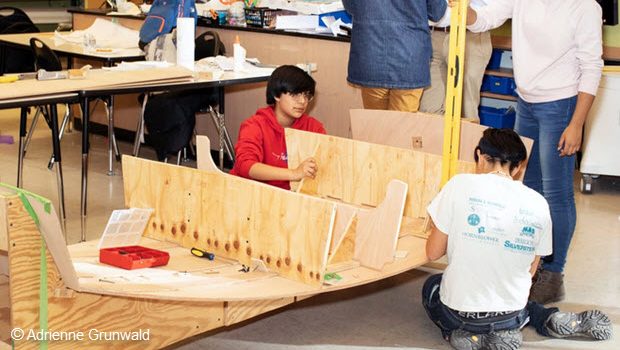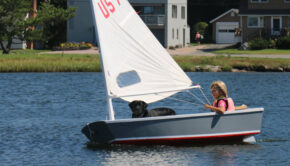Reading, Writing, and Boatbuilding
Published on June 17th, 2019
At Middle School 88 in Park Slope, New York, there is a security guard at the entrance, long hallways plastered with art, and students, slouching on a sofa, staring into their phones. It is a pretty typical scene.
Except for Room 128. For most of this school year, the room has contained the makings for a handmade, full-size wooden boat. Specifically an Optimist dinghy.
Under the direction of Laura Botel, the program coordinator of Brooklyn Boatworks, a nonprofit after-school program, and volunteers from the organization, the students met for two hours a week. Here, they mastered new manual skills and a new vocabulary, including words like transom, daggerboard, and thwart.
Five other New York City schools in the Brooklyn, Manhattan, and Queens boroughs also built Optis this year.
Last fall at M.S. 88, the boat building process began with four unfinished sheets of marine plywood, design plans and some basic hand tools like screwdrivers, small saws, and cordless drills. The idea was to build a seaworthy boat entirely by hand and then sail it in an inlet on the East River on an appointed day, rain or shine, by the end of the school year.
The day came on June 10th. And it rained, but it happened: A small flotilla of Optis, each one of which had been built inside classrooms across the city, set sail, holding one student-builder and one adult.
Brooklyn Boatworks was founded in 2005 by Carl Persak and Jeremy Wurmfeld, naval architects in the borough. “I wanted to find a way to teach boatbuilding that was 95 percent student hands, and that’s hard to do,” said Persak.
Also challenging, at first, was selling the idea to school administrators. “The funny thing is, there are quite a few nautical people kicking around New York City, even principals, and they know what it means to build a boat right away,” noted Persak. “It’s not like building a building; you have to make it move, make it float, make it withstand winds.”
The hands-on nature of the project appealed to many students at M.S. 88. “They’re understimulated,” said Jack Wasylyk, an English teacher there. “They’re dying for something to do and latch onto.”
Boatbuilding also requires a singular focus. “You can’t hold a phone and hold a drill at the same time,” said Schulman.
While it costs $18,000 to build each Opti through the program, schools with a large concentration of low income students pay $8,000; Brooklyn Boatworks pays the balance. Only one private school has ever paid the full fee, admitted Schulman.
Students quickly learn how physical boatbuilding is — kneeling and sawing, gluing and sanding, and redoing whatever didn’t work the first time. In an era much defined by instant gratification, this workshop is very much about process.
“For most of our students, this is the longest thing they’ve ever done,” observed Schulman.
Kawthar Alsahqani, an eighth-grader at M.S. 88, said she thought the project would be much harder. “But because it’s something I wanted to learn, it’s easy,” she explained, while leaning into the boat with a power drill.
The program also offers a respite from the emotional storms many middle-schoolers experience, teachers said.
“Middle school is a battlefield,” shared Botel. The boatbuilding workshop gives students ownership over a project, she explained. “To complete it, they see there are times they really do need each other.”
For example, there was a moment when a group of students laminated five long strips of cedar together. “Sometimes we don’t even communicate,” Zeed Alfatimi, a seventh-grader, said. “We just know what to do.”
Dana Garcia, a sixth-grader, said she really enjoyed building the boat. “I sawed many pieces of it and we got to use epoxy, which my parents thought was pretty cool,” she said. “Sawing is actually pretty hard. You have to practice a lot. You have to be safety conscious and patient. We wear gloves so we don’t get cut and safety glasses so no sawdust gets into our eyes.”
Students also had the opportunity to use math and science in the workshop. “When it came to our measurements, we were always trying to get everything right and we had a lesson in the science of sailing, how to use the wind,” Dana said.
Dana, it seems, has caught the building bug. “I’d like to do a sculpture or another boat or a treehouse,” she said.
Other students felt empowered from the experience, too.
“I love learning new stuff,” Karla Miranda, a seventh-grader, said. “Before I was just doing basic girl things —- I’d watch TV, go outside, do homework. I got more comfortable using tools and how to control them,” she continued. “I didn’t know I could do all this.”
Zeed loved building the boat from the very beginning. “I would get to use saws, which is uncommon. Drafting is really cool — you start out with a plain piece of wood and then you completely change it,” he said. “The most fun part is sawing and sanding. I’m a lot more crafty now.”
In April, the M.S. 88 students named their finished Opti “Pizza Sail.” Frank Perez Gomez, an eighth-grader, offered his hand-drawn name design for the boat. It used pizza ingredients to create the letters.
For the first time, the students saw how all the pieces of a sailboat fit together, including its crisp, white sail. While learning how to hoist the sail, they handled colored ropes of varying thicknesses — black, red, blue and black and orange, which attach the sail to the boat.
“We call them lines,” explained Mr. Wasylyk, the English teacher, who is a lifelong sailor with a captain’s license and the owner of a 38-foot sailboat he has skippered to Nova Scotia. “You call them string or ropes, but once you’re on a boat, you call it a line.”
Brooklyn Boatworks then transported Pizza Sail, as well as the finished Optis from the other schools, to a Brooklyn workshop in Gowanus where Boatworks staff members coated them with epoxy, varnish and fiberglass tape to make the boats watertight.
The new Optis will join a fleet of those built in previous years, which are made available to former student builders and groups like the Girl Scouts, during the summer. The boats are stored in multiple locations in Brooklyn, including the Pier 5 Brooklyn Bridge Park Boathouse. The very first student-made Optis are at Derecktor Shipyards in Mamaroneck.
For some Boatworks alumni, the program’s lessons resonate years later.
Jovon Ferguson, who graduated from Wheaton College in Massachusetts last year with a degree in political science, helped build an Opti when he was in seventh grade at the Brooklyn Collaborative School. He works with Brooklyn Boatworks once a week.
Now that he is leading students in the process, Ferguson says he appreciates the bond that boatbuilding as a team can produce. “Every day it’s there, that we’re doing that rare thing together,” he said.
“We collect students’ cellphones at the start of each class,” said Ferguson. “It really draws in a student who wants to do something different.”
When asked what he remembered most about his own boatbuilding experience in middle school, Ferguson said that he loved the anticipation of what came next in the weekly process.
Zeed, the seventh grader who found an appreciation for drafting, said he felt the same way. “You want to finish it,” he said. “And you have to wait another week.”
Source: Edited from story in New York Times.









 We’ll keep your information safe.
We’ll keep your information safe.